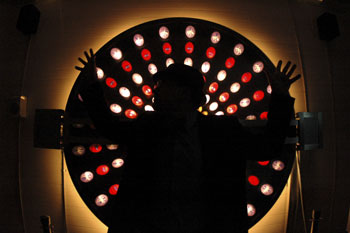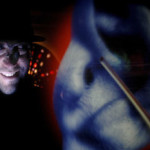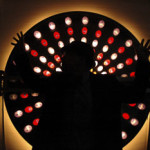'Patamechanics is a method of discovering/manifesting artifacts' much like those of the ancient Wonder-rooms, 'which symbolically attribute their properties described by their virtuality to their lineaments.' A Patamechanical artifact or device is displayed with the intention of validating the existence of a realm or entity 'supplementary to this one; or, less ambitiously, describe a universe which can be - and perhaps should be - envisaged in the place of the traditional one.'The primary goal of the Musée Patamécanique is to explore the meaning and possibilities of Patamechanics [...] [1]
Le Musée Patamécanique can only be seen by guided tour, courtesy of the curator, Neil Salley. Its location is a secret, although anyone can tour Le Musée and Salley is a gracious host. To learn the location all one must do is make an appointment. You are allowed to know, however, that Le Musée is located in Bristol, Rhode Island and is worth the trip.
Le Musée is an experience: part performance, part history, part fantasy. It is simultaneously illuminating and mysterious, and even having spent a healthy amount of time within its walls I am still left with questions, and yet those questions are also part of the dream-scape created by the Patamechanics and the tour. It is an experience that will be unique for each viewer, and I write about it in my own voice, and from my own experience, because there is no objective approach to something that becomes so wholly internalized and personal as a tour of Le Musée.
My travelling partners, George and Phaedra, and I were met on the grounds by Salley, smiling broadly in a suit with bow tie and fedora hat. He led us along a path lined by reproductions of classic sculptures to Le Musée, where we were shown to a tiny foyer and served a glass of sherry. He told of of the history of Patamechanics, some of which I've excerpted above. We were shown a map of the full museum, and told that today's tour would only take us to a small section of it. Moments later, Salley slipped away and left us to our own conversations.
The tiny foyer was packed with images and knick-knacks that hinted at the evolving history of Patamechanics, from surrealist and dadaist images to a phrenology bust, to photos of Disneyworld and toys from McDonalds. After a few moments, a ringing alerted us to a door labeled "Ring bell for ... fingers" with a glowing doorbell button where I have typed elipses. After the second ring Phaedra rang back, and Salley appeared, laughing at the fact that it took us two rings to respond.
With the door closed, we took in Le Musée Patamécanique. Lit only by the tiny internal workings of the pieces, we tried to find our bearings in the room. Most pieces were black, and one or two shown with bright blues or greens. Along one wall a projection of a wavy image, like a broken oscilloscope, quivered benignly. Thus began the tour.
Salley read from his book as he guided us from piece to piece, a Willy Wonka in the dark, a historian of his own distorted version of history, a curator of a museum of confounding distortions. We careened from "The Resonance Machine" to "The Resonating Chamber" before stopping at the "Crank-O-Wank", a device made of a hand-crank generator, bicycle tires, and a series of fire alarm bells. With prodding, Phaedra cranked the device until the bells made a deafening clang, and the room sprung to life. Immediately Salley had us by the elbow and led us to "An Olfactory Lighthouse", an amazing device with metallic tubes blowing various scents derived from commercial products. We spent several minutes making a circuit around the device, all three of us proclaiming delight or disgust at the smells issued forth. From there he took us in turn to the many pieces in the room, each a fascination unto itself, part of a larger vision of a world distorted, proof of a history that had never occurred.
The key to Salley's tour was his presentation of each piece as a genuine and historied work of science. He mixed true history with false, layered literary references with science fiction, and famous poems with those of his own invention. Le Musée, in essence, was history because it could not NOT be history; it created its own truth, and supported these facts with material evidence.
The centerpiece of Le Musée, and by far its most accomplished piece, is "A Time Machine," a spinning disc nearly eight feet across that sounded like a train coming down the tracks, and when it reached full-speed suddenly unveiled a visual treat that cannot be described. In some small way, time opened, or at least a perception of time, and the visual illusion created became secondary to the alternative reality that was illuminated. It would make Jules Verne cry.
Equally as enjoyable as the experience of the mysterious machines is the understanding that they are all based on real science, or adapted from science fiction, and thus can be 'understood' as mechanical machines with logical workings. "A Time Machine" is essentially a large kinetoscope, although the complexity of its workings and the beauty of its results are far more impressive than figuring out the science behind them. This, ultimately, is what Le Musée is all about: that knowing how something is done can often be far less important that understanding what it evokes. By giving up one's desire to understand the logic of a machine, one can see the beauty of its workings.
I stood for several minutes before the piece "The Dream Of Timmy Bumble Bee", trying to figure out how it works. The device houses the carcuses of several bees, each held by its wings with electrical clips whose wires climb the walls to a series of glass jars, each showing a re-animated bee made of pure light, fluttering in the black space. Eventually I came to realize that I didn't really care how it worked, as the beauty and optimism of the dream it created was far more pleasing to me than knowing what voltage the wires carried. It was a true Patamechanic device, evoking a dream-world far superior to its logical counterpart.
As the gracious host and tour guide, Salley is as much a part of the experience as the devices. He hints at being a Patamechanic himself, and presents his museum with the love of a curator and the passion of a scientist. While the museum is still open and the weather is still fair, make your appointment and travel to see this work. Your vision of what the world might be will be permanently altered.
----
[1] - Taken from the website of Le Musée Patamécanique. Please refer to this site for related footnotes and quote attributions.
----
Links:
Le Musée Patamecanique
Le Musée is available by appointment only. You can contact the curator via the website above or by clicking here.
All images are courtesy of Le Musée Patamecanique and the author. Photos by Richard Dionne Jr.






